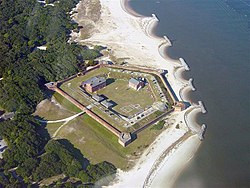Fort Clinch
|
Fort Clinch
|
|

Fort Clinch aerial view, October 2003
|
|
| Location | Amelia Island, Nassau County, Florida |
|---|---|
| Coordinates | 30°42′16.88″N 81°27′16.06″W / 30.7046889°N 81.4544611°WCoordinates: 30°42′16.88″N 81°27′16.06″W / 30.7046889°N 81.4544611°W |
| Built | 1847-1869 |
| Architectural style | Brick Masonry |
| Visitation | 167,000 (an average year) |
| NRHP Reference # | 72000343 |
| Added to NRHP | November 15, 1972 |
Fort Clinch is a 19th-century masonry coastal fortification, built as part of the Third System of seacoast defense conceived by the United States. It is located on a peninsula near the northernmost point of Amelia Island in Nassau County, Florida. The fort lies to the northeast of Fernandina Beach at the entrance to the Cumberland Sound (Florida), in the northeast part of the state. Today it is included within the boundaries of Fort Clinch State Park.
This site was first fortified in 1736 by the Spanish, when they held colonies in Florida. From 1736, various nations to control the territory have garrisoned and fortified this site to protect the entrance to the St. Marys River and Cumberland Sound.
After the end of the Second Seminole War, the United States started construction of a fort, later named Fort Clinch, in 1847. It was part of its Third System of coastal defenses conceived earlier in the century, which guided fortifications throughout this period. The fortified compound is pentagonal in shape, with both inner and outer walls, and consists of almost five million bricks. There are corner bastions and embrasures in the outer walls and several structures in the interior courtyards, including a two-story barracks. The fort was named in honor of General Duncan Lamont Clinch after his death in 1849. General Clinch fought in the War of 1812 and was an important figure in the First and Second Seminole Wars.
Confederate forces seized the fort in early 1861. It was used as a safe haven for Confederate blockade runners during the first year of the Civil War. However, changes in technology, specifically, the development of rifled cannon, had improved weaponry to the point that the fort's brick walls were vulnerable to attacks and thus obsolete. In March 1862 General Robert E. Lee ordered abandonment of the fort in order to use scarce troops in other areas. Federal troops re-occupied the fort in early 1862, taking control of the adjacent Georgia and Florida coasts. They used the fort as the base of Union operations in the area throughout the Civil War.
...
Wikipedia
